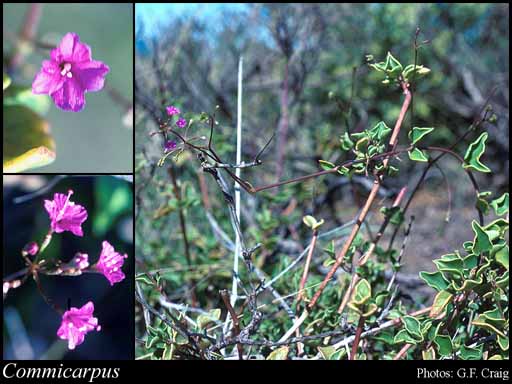- Reference
- Contr.Bolus Herb. p373 (1909)
- Name Status
- Current

Scientific Description
Family Nyctaginaceae.
Habit and leaf form. Shrubs. Leaves cauline. Young stems cylindrical. Stem internodes solid. Mesophytic. Leaves opposite; petiolate; simple. Leaf blades entire; ovate (to deltoid); one-veined (entire or sinuate or undulate); cross-venulate; cordate to cuneate at the base (subcordate). Leaves without stipules. Leaf anatomy. Hairs present, or absent; glandular hairs present. Stem anatomy. Secondary thickening anomalous; via concentric cambia.
Reproductive type, pollination. Fertile flowers hermaphrodite. Unisexual flowers absent. Plants hermaphrodite.
Inflorescence and flower features. Flowers aggregated in ‘inflorescences’; in umbels (capitula or branched verticels or unbranched verticels). The terminal inflorescence unit cymose. Inflorescences terminal, or axillary; with involucral bracts, or without involucral bracts; pseudanthial, or not pseudanthial. Flowers pedicellate (pedicels glabrous or sparsely glandular viscid); bracteate (small). Bracts deciduous. Flowers bracteolate (small, herbaceous or membranous or often glandular); small, or medium-sized; regular; cyclic; tricyclic. Free hypanthium absent. Perianth sepaline; 5; 1 -whorled; joined. Calyx present; (i.e. the perianth) (3–)5(–8); 1 -whorled; gamosepalous; blunt-lobed; valvate, or plicate in bud; tubular, or funnel-shaped (or trumpet shaped); regular; white, or pink, or purple (magenta-purple); base persistent. Corolla absent. Androecial members definite in number. Androecium 2–6. Androecial sequence determinable, or not determinable. Androecial members adnate (to the perianth tube), or free of the perianth; markedly unequal; free of one another, or coherent; if coherent, 1 - adelphous (the filaments basally connate); 1 -whorled. Androecium exclusively of fertile stamens. Stamens 2–6; all more or less similar in shape; hypogonous; inflexed in bud. Anthers dehiscing via longitudinal slits; introrse; tetrasporangiate. Gynoecium 1 carpelled. The pistil 1 celled. Carpels reduced in number relative to the perianth. Gynoecium monomerous; of one carpel; superior. Carpel stylate; apically stigmatic; 1 ovuled. Placentation basal. Ovary stipitate (shortly stipitate). Ovules ascending; non-arillate; campylotropous, or hemianatropous.
Fruit and seed features. Fruit non-fleshy. The fruiting carpel indehiscent; an achene, or nucular. Fruit 1 celled; 1 seeded. Seeds endospermic, or non-endospermic. Perisperm present. Embryo well differentiated (large). Cotyledons 2. Embryo curved, or straight, or bent.
Etymology. From the Greek for "gum" and "fruit", referring to the viscid fruits.